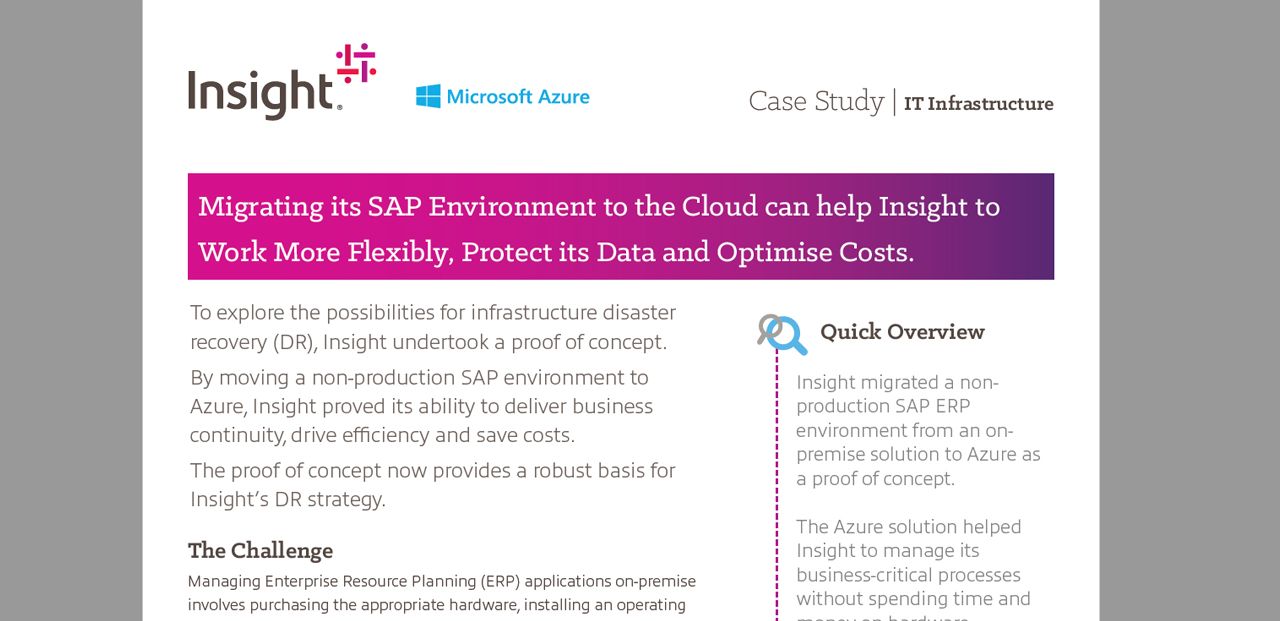Client story Migrating SAP Environments to the Cloud
By Insight UK / 22 Jul 2019 / Topics: Modern infrastructure Cloud Microsoft Azure
By Insight UK / 22 Jul 2019 / Topics: Modern infrastructure Cloud Microsoft Azure

To explore the possibilities for infrastructure disaster recovery (DR), Insight undertook a proof of concept. By moving a non-production SAP environment Azure, Insight proved its ability to deliver business continuity, drive efficiency and save costs. The proof of concept now provides a robust basis for Insight’s DR strategy.
Managing Enterprise Resource Planning (ERP) applications on-premise involves purchasing the appropriate hardware, installing an operating system and accessing the applications needed to get up and running. As a result, on-premise solutions can be inflexible, and Insight was concerned that its current system could hinder business expansion. Another barrier to flexibility is the length of time it can take to add to existing infrastructure. Purchasing additional equipment means going through a lengthy procurement cycle.
A move to a new ERP environment would require Insight to acquire more hardware, copy the existing infrastructure or start from scratch with a completely new installation.
Previously, when Insight re-platformed SAP, the cost outlay for the onpremise infrastructure to support it was considerable.
Insight also wanted to improve its business continuity and ensure that its data was easily recoverable and highly available. But in the event of a DR situation, the on-premise solution wouldn’t be able to deliver the rapid recoverability that Insight wanted to achieve.
Insight carried out a proof of concept project for its EMEA operation, moving a replica of its SAP production environment to the cloud.
Insight decided to run its proof of concept by migrating a non-production SAP ERP environment to Microsoft Azure, which offers expert hosting of complex business solutions. With Azure, Insight is able to access new software, equipment and applications using templates in the cloud.
The cloud-based solution allows Insight to adapt more quickly to a rapidly evolving marketplace by being able to scale up its infrastructure when required.
The combination of automation and the ease of increasing hardware resources allows Insight to plan more efficient ways of running processes. The solution enables Insight to reduce its SAP utilisation to around 20% during the day, when power is more costly. While at night, when power is cheaper, SAP can be fully utilised for heavy duty workloads such as batch processing of its large and complex databases.
Migrating to Azure proves that Insight can create a builtin DR facility. If data needs to be recovered, the cloud solution offers instant availability across Insight’s data centres, instead of leaving hardware sitting unused.
The Azure solution gives Insight the option to gain additional discounts to the overall cost. By reserving equipment and capacity in the cloud for use in future years, Insight is able to make savings compared with the original re-platforming.